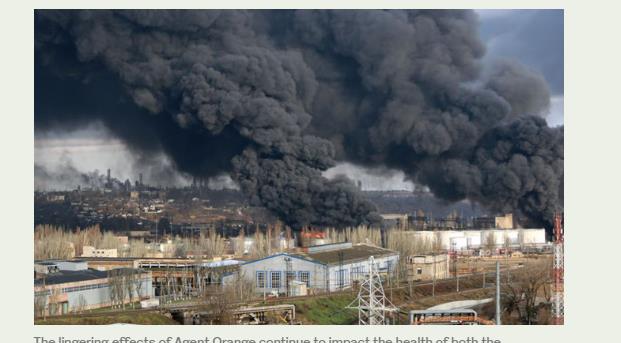
The world is today experiencing several armed conflicts. War, with its harrowing consequences, extends its reach beyond human casualties and displaced communities, leaving an indelible mark on the environment. Unfortunately, the devastating impacts of armed conflicts on nature are often overlooked. That is why it is important that we explore the multifaceted and profound environmental consequences of war, shedding light on the voiceless and innocent victims that suffer long after the guns fall silent.
The environmental toll of war is vast and complex, encompassing a spectrum of destructive forces that alter landscapes, pollute air and water and disrupt ecosystems. The extensive use of weaponry, deliberate destruction of infrastructure and displacement of populations contribute to a chain reaction of ecological consequences. In fact, from soil contamination to deforestation, the collateral damage inflicted on the environment could echo for generations.
A report published on the Social Science Research Network this month revealed some alarming statistics regarding greenhouse gas emissions during the first two months of Israel’s war on Gaza. The emissions for this period surpassed the annual emissions of 20 individual countries and territories. The study, titled “A Multitemporal Snapshot of Greenhouse Gas Emissions from the Israel-Gaza Conflict,” estimated 281,315 tonnes of carbon dioxide were emitted as a result of the war in the first 60 days after Oct. 7. According to co-author Benjamin Neimark, a senior lecturer at London’s Queen Mary University, this is equivalent to “75 coal-fired power plants operating for a year.”
It also emphasized that the carbon footprint for rebuilding Gaza is projected to result in total annual emissions higher than those of more than 130 countries, placing them on par with New Zealand in terms of environmental impact. These findings underscore the environmental consequences of armed conflicts and highlight the urgent need for ecological factors to be considered in conflict resolution and reconstruction efforts.
While the immediate impacts of war are visible in the form of bombed-out buildings and displaced populations, the reconstruction phase also contributes to environmental degradation. The rebuilding of infrastructure often involves resource-intensive processes that put a further strain on the supply of natural resources. Additionally, the disposal of the debris and waste generated during reconstruction poses challenges in terms of managing pollution and maintaining environmental sustainability.
Throughout history, wars have left indelible scars on the environment, altering landscapes and ecosystems in ways that endure for generations. One glaring example is the Vietnam War, where the widespread use of herbicides, particularly Agent Orange, had severe ecological repercussions. Defoliation campaigns resulted in the destruction of vast expanses of lush forest, causing soil erosion, loss of biodiversity and contamination of water sources. The lingering effects of Agent Orange continue to impact the health of both the environment and the local population.
From soil contamination to deforestation, the collateral damage inflicted on the environment could echo for generations.
Dr. Majid Rafizadeh
The Syrian civil war also brought to light the multifaceted environmental toll of war. The conflict witnessed the deliberate targeting of critical infrastructure, including water treatment plants. The destruction of such facilities not only deprives civilians of access to clean water, but also leads to the contamination of water sources, posing a severe threat to public health and ecosystems. Another contemporary example is the conflict in Yemen, where the hostilities have led to the neglect and degradation of the environment.
One of the current problems is that modern weaponry has introduced new dimensions of environmental destruction. Depleted uranium ammunition, which has been employed in conflicts by the US and other militaries, poses long-term environmental and health risks. Its radioactive nature can contaminate soil and water, affecting ecosystems and endangering human health over extended periods.
Furthermore, air raids and bombings release pollutants into the atmosphere, contributing to air and soil pollution. For example, the destruction of industrial facilities can release hazardous chemicals, as seen in conflicts like the Syrian civil war, where attacks on chemical plants resulted in the release of toxic substances, further compromising air and water quality.
One of the most immediate effects armed conflicts have on the environment is the release of pollutants into the atmosphere and soil. The detonation of explosives and the burning of infrastructure contribute to air pollution, releasing harmful particles and toxins. The fallout settles on the soil, contaminating it with hazardous substances that can have long-lasting effects on both the environment and public health.
It is very important to point out that clean water is a critical concern in times of war. The deliberate targeting of water infrastructure, such as dams and treatment plants, exacerbates water scarcity issues. Meanwhile, displacement and increased demand strain available water resources, leading to conflicts over access. Moreover, the pollution of water sources due to the release of contaminants during warfare poses a severe threat to aquatic ecosystems and the health of communities that depend on these water bodies.
In a nutshell, the environment stands as an often-overlooked casualty of war, with nature being forced to bear the scars of destruction and degradation. From polluted air and water to depleted biodiversity and strained ecosystems, the environmental toll of war is a pervasive and enduring crisis. It is crucial that the international community recognizes the victims of environmental devastation.
• Dr. Majid Rafizadeh is a Harvard-educated Iranian-American political scientist.
X: @Dr_Rafizadeh
Disclaimer: Views expressed by writers in this section are their own and do not necessarily reflect Arab News" point of view












